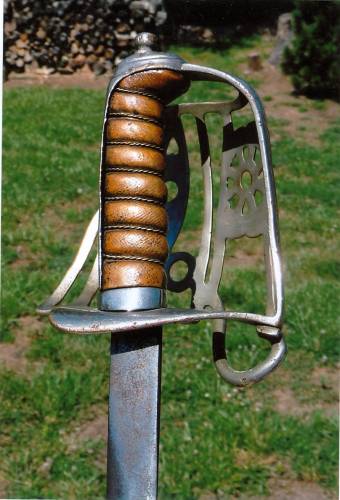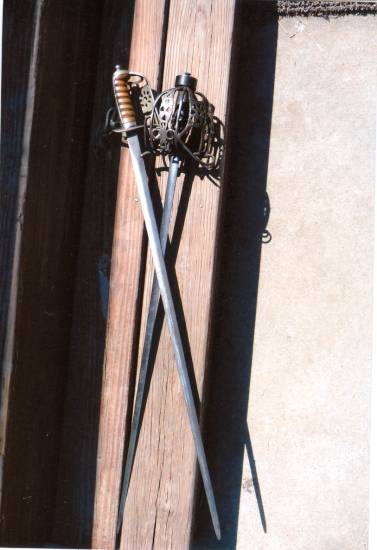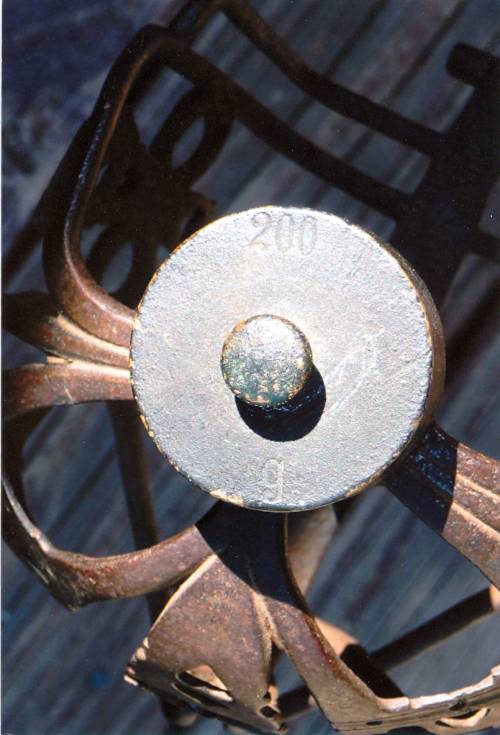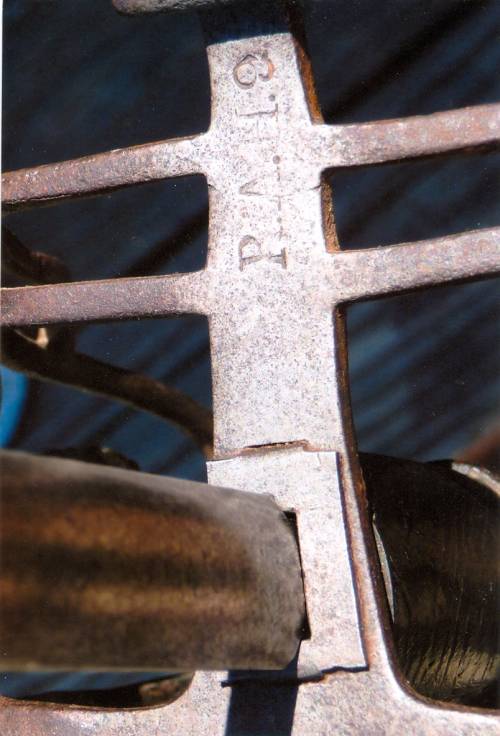| Author |
Message |
|
Lin Robinson
|
 Posted: Sat 23 Jul, 2011 6:42 pm Post subject: Two Scottish Swords Posted: Sat 23 Jul, 2011 6:42 pm Post subject: Two Scottish Swords |
 |
|
I recently received photos of two swords from a gentleman who read an article of mine in The Highlander on the subject of Scottish swords. He was seeking some information about them. Frankly I am stumped concerning certain aspects of these swords.
The basket hilt seems to be a standard 1828 pattern from what I can see in the closeup of the pommel and the full shot of the two swords together. The markings on the quillon appear the be "R. A. H. 9". On the pommel is "200" and "g". The pommel itself appears to be a very large, thick disk. I cannot say that I have ever seen one like that before and it looks awkward. The owner says there are no other markings on the sword other than what he photographed.
The half basket is even more curious. The shape of the hilt and the pommel are very much like that of the 1822 Infantry Officers Pattern and the 1827 Pattern swords pictured in Withers" book. The half basket is the real mystery as I have not see one like it before on what appears to be a 19th c. blade nor can I find a reference for one like it in any of my literature. Withers' book, again, shows similar hilts on two late 18th c. swords but neither very closely resembles the one on this sword. The blade is also quite plain and the owner says he found no markings of any kind on this sword.
Anybody seen anything like these before? I had to scan the photos to attach and they are not quite as clear as the originals but I think there is enough detail to help with ID. I expect there is an easy answer to this, I just do not have it.
 Attachment: 37.23 KB Attachment: 37.23 KB

 Attachment: 32.72 KB Attachment: 32.72 KB

 Attachment: 28 KB Attachment: 28 KB

 Attachment: 47.66 KB Attachment: 47.66 KB

 Attachment: 46.53 KB Attachment: 46.53 KB

Lin Robinson
"The best thing in life is to crush your enemies, see them driven before you and hear the lamentation of their women." Conan the Barbarian, 1982
|
|
  |
 |
Justin Lee Hunt

Location: North Baltimore OH Joined: 28 Jun 2011
Posts: 38
|
 Posted: Sat 23 Jul, 2011 11:28 pm Post subject: Posted: Sat 23 Jul, 2011 11:28 pm Post subject: |
 |
|
These are a bit out of the periods I normally look into. Having said that, do you know how the owner came by them? My first thought was that they might be cobbled together from antique parts. That would be a simple answer, but again, this period isn't my forte'. Please excuse the pun.
I opperate a website for my reenactment troop it's www.orderoftherouseclan.org Be sure to check out our forums www.orderoftherouseclan.proboards.com
|
|
    |
 |
David Cooper

|
 Posted: Sun 24 Jul, 2011 12:03 am Post subject: Posted: Sun 24 Jul, 2011 12:03 am Post subject: |
 |
|
The disc almost looks like a scale weight. It would be interesting to take it off and weigh it to see if it comes close to 200 grammes. ( perhaps slightly less if it has had a hole drilled through it.)
The journey not the destination
|
|
  |
 |
|
Lin Robinson
|
 Posted: Sun 24 Jul, 2011 4:37 am Post subject: Posted: Sun 24 Jul, 2011 4:37 am Post subject: |
 |
|
| Justin Lee Hunt wrote: | | These are a bit out of the periods I normally look into. Having said that, do you know how the owner came by them? My first thought was that they might be cobbled together from antique parts. That would be a simple answer, but again, this period isn't my forte'. Please excuse the pun. |
The owner said he collected them over the last twenty years. He did not mention from where. I too had the feeling that the half basket might be a parts sword. The photos, while clear, provide a limited perspective and shots from other angles might give some clues. He mailed the information and in my written reply I suggested we discuss further via email and I may be able to get more answers once we establish that contact.
Thanks for the reply.
Lin Robinson
"The best thing in life is to crush your enemies, see them driven before you and hear the lamentation of their women." Conan the Barbarian, 1982
|
|
  |
 |
|
Lin Robinson
|
 Posted: Sun 24 Jul, 2011 4:39 am Post subject: Posted: Sun 24 Jul, 2011 4:39 am Post subject: |
 |
|
| David Cooper wrote: | | The disc almost looks like a scale weight. It would be interesting to take it off and weigh it to see if it comes close to 200 grammes. ( perhaps slightly less if it has had a hole drilled through it.) |
That crossed my mind also. The side view of the hilt is not very detailed so I don't know how it is attached. Why would something like that be used instead of a pommel?
Thanks for the reply.
Lin Robinson
"The best thing in life is to crush your enemies, see them driven before you and hear the lamentation of their women." Conan the Barbarian, 1982
|
|
  |
 |
|
Jonathan Hopkins
|
 Posted: Sun 24 Jul, 2011 8:39 am Post subject: Posted: Sun 24 Jul, 2011 8:39 am Post subject: |
 |
|
|
The sword with the saber-like grip is reminiscent of a sword illustrated in "Swords for the Crimea: Some Scottish Officers' Swords Manufactured for Britain's War With Russia, 1854-56" by Stephen Wood (The Journal of the Arms and Armour Society, London, Vol. XVIII, No. 3, pp 115-135). There are some differences, for example the sword in the article has a different blade, a full basket, and lacks the prominent tang button on the sword you pictured above. (If you need help with a copy of the article please send me a PM.) The blade on your friend's sword looks like the type found on the US M1860 Field & Staff Officer's sword. If it is a cobbled together piece the blade stands out as the most wrong element, although it is hard to tell without seeing the sword firsthand.
|
|
  |
 |
Glen A Cleeton

|
 Posted: Sun 24 Jul, 2011 9:54 am Post subject: Posted: Sun 24 Jul, 2011 9:54 am Post subject: |
 |
|
| Quote: | | the type found on the US M1860 Field & Staff Officer's sword |
At a passing glance I might agree but the blade pictured would be huge on a staff&field hilt. Also, that the blade shape of the posted sword is not as defined and a longer ricasso than a late S&F blade (those post 1872 blades). Width of blade as well.
Cheers
GC
|
|
  |
 |
|
Jeffrey Faulk
|
 Posted: Sun 24 Jul, 2011 10:05 am Post subject: Posted: Sun 24 Jul, 2011 10:05 am Post subject: |
 |
|
| Lin Robinson wrote: | | David Cooper wrote: | | The disc almost looks like a scale weight. It would be interesting to take it off and weigh it to see if it comes close to 200 grammes. ( perhaps slightly less if it has had a hole drilled through it.) |
That crossed my mind also. The side view of the hilt is not very detailed so I don't know how it is attached. Why would something like that be used instead of a pommel?
Thanks for the reply. |
My guess is that it may be a hasty repair of some sort? Perhaps the pommel was threaded on and broke off at the thread; someone wanted to replace it and decided to use something heavy-ish like the pommel, but without enough thread to work with they had to use something flat that would fit what was left. Hence, scale weight?
|
|
  |
 |
Chad Arnow
myArmoury Team


|
 Posted: Sun 24 Jul, 2011 10:06 am Post subject: Posted: Sun 24 Jul, 2011 10:06 am Post subject: |
 |
|
| Lin Robinson wrote: |
That crossed my mind also. The side view of the hilt is not very detailed so I don't know how it is attached. Why would something like that be used instead of a pommel?
Thanks for the reply. |
Perhaps the original pommel got lost along the way somewhere and all someone had handy was a 200g weight to replace it.
I doubt the weight was OEM. 

ChadA
http://chadarnow.com/
|
|
    |
 |
|
Jonathan Hopkins
|
 Posted: Sun 24 Jul, 2011 11:46 am Post subject: Posted: Sun 24 Jul, 2011 11:46 am Post subject: |
 |
|
| Glen A Cleeton wrote: | | Quote: | | the type found on the US M1860 Field & Staff Officer's sword |
At a passing glance I might agree but the blade pictured would be huge on a staff&field hilt. Also, that the blade shape of the posted sword is not as defined and a longer ricasso than a late S&F blade (those post 1872 blades). Width of blade as well.
Cheers
GC |
That is why I said "looks like" and not "is". Maybe resembles is a better way to put it  It is not like any regulation or variant blade I have seen on a British military sword. It is not like any regulation or variant blade I have seen on a British military sword.
Last edited by Jonathan Hopkins on Sun 24 Jul, 2011 12:06 pm; edited 1 time in total
|
|
  |
 |
Thom R.

|
 Posted: Sun 24 Jul, 2011 12:00 pm Post subject: Posted: Sun 24 Jul, 2011 12:00 pm Post subject: |
 |
|
|
Hi LIn, I agree with Jonathan. The blades do not look regulation in any way (and possibly not British). Also the various hilt elements being "off" like the grip on the half basket and the pommel on the other makes me think these are composite pieces, as in, very composite. tr
|
|
  |
 |
|
Lin Robinson
|
 Posted: Sun 24 Jul, 2011 12:35 pm Post subject: Posted: Sun 24 Jul, 2011 12:35 pm Post subject: |
 |
|
| Thom R. wrote: | | Hi LIn, I agree with Jonathan. The blades do not look regulation in any way (and possibly not British). Also the various hilt elements being "off" like the grip on the half basket and the pommel on the other makes me think these are composite pieces, as in, very composite. tr |
Thom...
I agree completely. All the 19th c. British military swords I have seen had some degree of decoration on them, either pure decoration or the maker or retailer's names. There are no proof disks to be seen on either. While I cannot tell for sure from the photos, there does not appear to be nearly enough rust on either blade to have obscured any markings. I mentioned this in the letter I sent to the owner. Again, I hope he will furnish an email address so we can communicate more easily.
Thanks for all the input...
Lin Robinson
"The best thing in life is to crush your enemies, see them driven before you and hear the lamentation of their women." Conan the Barbarian, 1982
|
|
  |
 |
|
Ralph Grinly
|
 Posted: Sun 24 Jul, 2011 2:53 pm Post subject: Posted: Sun 24 Jul, 2011 2:53 pm Post subject: |
 |
|
|
Just a guess, but I have doubts that that odd "pommel" actually is a scale weight, for two reasons. Most scales that I've seen have used brass to make the weights ( easier to work/cast ?? ) and, if that pommel is iron or steel it looks like it would have to weigh more than 200 grams ? Given the photo of the full sword, you can see just how relatively 'deep" the pommel is. I would think something like that, in steel, would def weigh more than 200 gram ?
|
|
  |
 |
|
Lin Robinson
|
 Posted: Sun 24 Jul, 2011 4:59 pm Post subject: Posted: Sun 24 Jul, 2011 4:59 pm Post subject: |
 |
|
| Ralph Grinly wrote: | | Just a guess, but I have doubts that that odd "pommel" actually is a scale weight, for two reasons. Most scales that I've seen have used brass to make the weights ( easier to work/cast ?? ) and, if that pommel is iron or steel it looks like it would have to weigh more than 200 grams ? Given the photo of the full sword, you can see just how relatively 'deep" the pommel is. I would think something like that, in steel, would def weigh more than 200 gram ? |
Admittedly that would be rather odd but then I see rather odd things every day. The view of the pommel in the photo of both swords makes it look pretty thick and, since 200 grams is equivalent to about 7.5 oz it is hard to see how something that large would weigh so little.
Lin Robinson
"The best thing in life is to crush your enemies, see them driven before you and hear the lamentation of their women." Conan the Barbarian, 1982
|
|
  |
 |
|
Jonathan Hopkins
|
|
  |
 |
|
|

